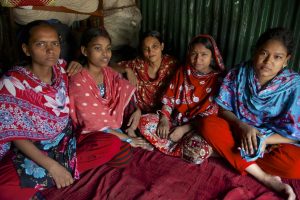Guest blog by Judith Hodge, independent consultant on global food and nutrition security, based in the UK, and one of the editors of the Nourishing Millions book.
Why there’s a chapter on obesity in Nourishing Millions
It’s taken some time but the nutrition community is finally talking about undernutrition and overnutrition in the same breath. In other words, talk is now about tackling the malnutrition that affects every country in the world, in all its forms. And that’s because the facts are overwhelming. There are 794 million people who do not get enough calories, but 2.1 billion people who are now obese or overweight. And numbers of children under five who are above a healthy weight are rapidly reaching the same level as those who are suffering from acute malnutrition or wasting.Most obese kids live in Asia and Africa
What’s more, this public health crisis is no longer just a problem facing high income countries. The focus is turning to the meteoric rise of the obesity epidemic in low and middle income countries. And it is children who are on the frontline – there are nearly 50% more overweight or obese under 5 year olds than there were in 1980. That’s a staggering 42 million – and nearly half of them live in Asia (a further 25% live in Africa). While the rate of increase in overweight appears to have slowed down in some high income countries, it’s a different picture for the rest of the world. In many developing countries the trajectory is still spiralling upwards, fuelled by rapid changes in economies and societies as people eat more processed foods and are less physically active.
Nourishing Millions brings together many powerful stories of success in tackling undernutrition. But to date, no country has reversed its obesity epidemic. Pockets of progress stem mainly from the levelling off of childhood obesity in some cities and countries with the highest prevalence. Yet these examples do offer some hope that progress is challenging but not impossible. More to the point, failure is not an option – unhealthy body weight carries a very high price, both for individuals and economies, particularly with its link to lifestyle-related non-communicable diseases (NCDs), such as diabetes and hypertension. Obesity causes 3.4 million deaths globally per year – and NCDs cost $2 trillion or 3% global GDP per year, putting pressure on already overloaded health systems.
Taxing sugary drinks – sweet success in Mexico
What’s interesting is that some of the lessons on how to tackle obesity are now coming from low and middle income countries. Take the example of Mexico’s sugar tax on sugary drinks (a story featured in Nourishing Millions). The Latin American country had the unfortunate accolade of experiencing the fastest growth of childhood obesity of any country. In just seven years (1999-2006), obesity among 5-11 year olds rose by 40%. It was a wake-up call – and no coincidence that Mexicans are also one of the world’s highest consumers of soft drinks.
After a well-coordinated advocacy campaign (and in the face of huge opposition from the powerful drinks industry), the soda tax finally came into effect on January 1, 2014, adding 10% to a liter bottle. Within one year, sales of sugary drinks had decreased by 12%. Even better news was the 17% lower consumption among poorer households and an increase in healthier untaxed purchases, such as bottled water.
Such stories of (albeit) early success have been a great boost to campaigns for a similar initiative in the UK, spearheaded by celebrity chef Jamie Oliver. Mounting evidence from countries such as Mexico and France that a sugar tax led to a fall in sales of unhealthy soft drinks was a persuasive one – resulting in a government u-turn, and the announcement that a similar tax will be introduced to the UK in 2018.
A healthy start in childhood – school-based health promotion programs
But taxes or subsidies on food are only part of the solution. It will take a wider range of measures working together to address the food environment, food systems, and behavioural change (ie at the individual level). And there’s growing consensus on what these measures should be. Promising interventions include nutrition labelling, improving the nutritional quality of food chains from ‘farm to fork’, restricting food advertising, and nutrition education.
Schools are a particularly fertile ground for implementing strategies to combat obesity. Healthy habits adopted in childhood can set the tone for healthier adult lifestyles. The school-based ACTIVITAL program in Ecuador (another Latin American country with a high burden of childhood obesity) focused on changing both individual behaviour and the school food environment. Following nutrition education for pupils, staff and parents, and increasing physical activity, results showed a decrease in consumption of processed foods, and in waist circumference and blood pressure among participating school children (read more in Chapter 9, Nourishing Millions).
There is an urgent need for properly evaluated success stories, such as ACTIVITAL’s, in tackling obesity from developing countries. Yet much of the current research comes from high income countries. For the many countries now facing the ‘double burden’ of under- and over- nutrition, control of nutrition policy and the food environment is as important for preventing obesity and chronic disease as it is for preventing stunting and wasting.- IFPRI




